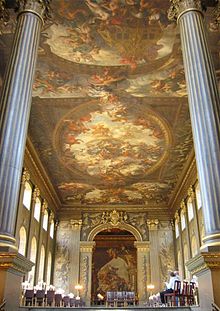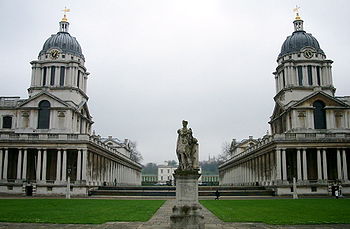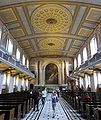- Old Royal Naval College
-
The Old Royal Naval College is the architectural centrepiece of Maritime Greenwich,[1] a World Heritage Site in Greenwich, London, described by the United Nations Educational, Scientific and Cultural Organisation (UNESCO) as being of “outstanding universal value” and reckoned to be the “finest and most dramatically sited architectural and landscape ensemble in the British Isles”.[2] The site is managed by the Greenwich Foundation for the Old Royal Naval College (Foundation), set up in July 1998 as a Registered Charity to “look after these magnificent buildings and their grounds for the benefit of the nation”. The grounds and some of its buildings are open to visitors. The buildings were originally constructed to serve as the Royal Hospital for Seamen at Greenwich, now generally known as Greenwich Hospital, which was designed by Christopher Wren, and built between 1696 and 1712. The hospital closed in 1869. Between 1873 and 1998 it was the Royal Naval College, Greenwich.
The Old Royal Naval College, on the south bank of the river Thames in Greenwich, London viewed from the north side. The Queen's House in the middle of the picture. The Royal Observatory visible in the background.
.
Contents
Greenwich Hospital
 John Michael Rysbrack's George II (1735) in the Grand Square of the Greenwich Hospital
John Michael Rysbrack's George II (1735) in the Grand Square of the Greenwich Hospital
Greenwich Hospital was founded in 1694 as the Royal Hospital for Seamen at Greenwich. It was established as a residential home for injured sailors, on the model of Les Invalides and the Chelsea Hospital. The pensioned sailors wore blue uniforms not unlike the red ones of the Chelsea pensioners. It occupied its riverside site for over 170 years, closing to pensioners in 1869.
In 1730 the Crown gave the impounded Derwentwater estates in Northumberland and Cumberland to the Greenwich Hospital Trustees, along with the lead mining rights on the moors. In 1778, the Greenwich Hospital built Lowbyer Manor as a coaching inn, known until 1858c as The Anchor Inn to acknowledge the association with the Hospital.
The founding Greenwich Hospital charity still exists; though no longer based at the site. It is a Royal Charity for the benefit of seafarers and their dependents, with the Secretary of State for Defence acting as the Crown's sole trustee. The charity now funds sheltered housing for former Royal Navy personnel and the school it spawned, the Royal Hospital School, now at Holbrook in Suffolk. The charity remains the ground landlord of the area between Romney Road and the river, and receives annual rent for the site from the Greenwich Foundation. However, under the terms of the National Maritime Museum Acts 1934 and 1989, the former buildings of the Royal Hospital School and the Queen's House are vested in the National Maritime Museum for as long as they are required for museum purposes.
On 5 January 1806, Lord Nelson's body lay in state in the Painted Hall of the Greenwich Hospital before being taken up the river Thames to St Paul's Cathedral for a state funeral.
The remains of thousands of sailors and officers, including those who fought in the Battle of Trafalgar, were removed from the hospital site in 1875 and reinterred in East Greenwich Pleasaunce or "Pleasaunce Park" (named after the former Royal Palace of Placentia on the site of the hospital).[3]
History of the buildings
Greenwich Hospital was built on the site of the Palace of Placentia, more commonly known as Greenwich Palace, the birthplace of Tudor queens Mary I and Elizabeth I and reputedly the favourite palace of Henry VII, who built it. The palace had fallen into disrepair during the English Civil War. With the exception of the incomplete John Webb building, the palace was finally demolished in 1694.
The hospital was created on the instructions of Mary II, who had been inspired by the sight of wounded sailors returning from the Battle of La Hogue in 1692. She ordered the King Charles wing of the Palace—originally designed by architect John Webb for King Charles II in 1664—to be remodelled as a naval hospital to provide a counterpart for the Chelsea Hospital for soldiers. Sir Christopher Wren and his assistant Nicholas Hawksmoor gave their services free of charge as architects of the new Royal Hospital. Sir John Vanbrugh succeeded Wren as architect, completing the complex to Wren's original plans.[4]
An early controversy arose when it emerged that the original plans for the hospital would have blocked the riverside view from the Queen's House. Queen Mary II therefore ordered that the buildings be split, providing an avenue leading from the river through the hospital grounds up to the Queen's House and Greenwich Hill beyond. This gave the hospital its distinctive look, with its buildings arranged in a number of quadrants. Its four main buildings (the 'Courts') are bisected north-south by a Grand Square and processional route, and east-west by an internal road from the East Gate (and gate-house) to the West Gate (and gate-house) by Greenwich Market in Greenwich town centre. The Grand Square and processional route running north-south maintained access to, and a river view from, the Queen's House and Greenwich Park beyond.
The principal buildings are King Charles Court (the oldest part dating back to the restoration), completed in 1705; Queen Mary Court (planned by Wren and Hawksmoor, but not built until after Wren's death, by Thomas Ripley), completed in 1742; Queen Anne Court (architects: Wren and Hawksmoor), and King William Court (designed by Wren, but completed by Hawksmoor and Sir John Vanbrugh). They were designed to hold 1,500 seamen.
Queen Mary Court houses the Chapel (designed by Wren but not completed until 1742). Its present appearance dates from 1779–89, having been rebuilt to a design by James Stuart after a devastating fire. King William Court is famous for its baroque Painted Hall, which was painted by Sir James Thornhill in honour of King William III and Queen Mary II (the ceiling of the Lower Hall), of Queen Anne and her husband, Prince George of Denmark (the ceiling of the Upper Hall) and George I (the north wall of the Upper Hall). The Painted Hall was deemed too magnificent for the pensioned seamen's refectory, and was never regularly used. It became a tourist destination, opened for viewing. In 1824 a ‘National Gallery of Naval Art’ was created in the Painted Hall, where it remained until 1936, when the collection was transferred to the National Maritime Museum newly established in the Queen's House and adjacent buildings.
On the riverside front of the north-east corner of King Charles' Court is an obelisk (designed by Philip Hardwick and unveiled in 1855) erected in memory of Arctic explorer Joseph René Bellot, who died in an unsuccessful attempt to rescue the members of John Franklin's ill-fated expedition to open a Northwest Passage in northern Canada.
The Greenwich Hospital buildings included an infirmary: the Dreadnought Seamen's Hospital (which took its name from a hospital ship moored off Greenwich in 1870). The treatment for tropical diseases moved in 1919 to the Seamen's Hospital Society hospital near Euston Square, in central London, to form the Hospital for Tropical Diseases. The Dreadnought Seaman's Hospital closed in 1986 with special services for seamen and their families then provided by the 'Dreadnought Unit' at St Thomas's Hospital in Lambeth.
Greenwich Hospital closed in 1869.[5]
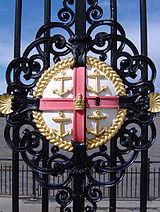 Badge of the Royal Hospital on the Water Gate of the Royal Naval College
Badge of the Royal Hospital on the Water Gate of the Royal Naval College
When the Greenwich Hospital was closed it was converted to a training establishment of the Royal Navy and from 1873 to 1998 it provided a number of courses for naval officers including being home to the Royal Navy's staff college. The staff course provided advanced training for mid-ranking officers. It became known as the "Navy’s university", auguring a new era of scientific training. It combined the functions and resources of the former Naval College at Portsmouth and the School of Naval Architecture and Marine engineering, which moved from South Kensington. In 1919 the Naval Staff College was also opened on the site.
During the Second World War the College’s major task was the training of fighting officers. Around 35,000 men and women graduated during that period. In 1943, the beautifully floored and paneled "Admiral’s House" on the north wing of King Charles Court was damaged by a direct hit from a German bomb; another hit the front of the building.
The Navy’s Department of Nuclear Science and Technology opened in 1959, and JASON, the department’s research and training reactor was commissioned in the King William building in 1962. JASON was fully dismantled in 1999.
In 1967 Francis Chichester was knighted on the river steps of the College by Queen Elizabeth II for being the first person to single-handedly circumnavigate the world by the old clipper route; it was also the fastest circumnavigation (nine months and one day).
From 1983 the relocated Joint Services Defence College also occupied much of the King Charles building.
The Royal Navy finally left the College in 1998 when the site passed into the hands of the Greenwich Foundation for the Old Royal Naval College. On the closure of the Royal Naval College, Britannia Royal Naval College became the sole naval college in the United Kingdom.
Since 1998 the site has had new life breathed into it through a mix of new uses and activities and a revival of the historic old site under the management and control of the Greenwich Foundation. The buildings are Grade I listed. In 1999 some parts of Queen Mary and King William, and the whole of Queen Anne and the Dreadnought Building were leased for 150 years by the University of Greenwich. In 2000 Trinity College of Music leased the major part of King Charles. This created a unique new educational and cultural mix.
In 2002 the Foundation realised its aim of opening up the whole site to visitors. It opens the Painted Hall, the Chapel and the grounds and a Visitor Centre to the public daily, free of charge, with guided tours available. The Old Royal Naval College has become open to students and visitors of all ages and nationalities accompanied often by music wafting from Trinity College. As Nathaniel Hawthorne said in 1863, "... the people are sooner or later the legitimate inheritors of whatever beauty kings and queens create."[6]
In 2005 the room where Nelson's coffin was held prior to his being laid-in-state was opened as the Nelson Room. The little side room contains a statue of Nelson replicating the one in Trafalgar Square, memorabilia, paintings and information. It can be seen on one of the guided tours that also include a visit to the undercrofts, the old skittle alley and crypt. A service is held in the chapel every Sunday at 11 am which is open to all. Public concerts are regularly held here and a wide variety of business and cultural events are held in the Painted Hall. The area is used by visitors, students, local people and film crews in a traffic-free environment that provides a variety of coffee shops, bars and restaurants, all incorporated within the old buildings, as part of a unique “ancient and modern” blend that support 21st century life in Greenwich.[7]
The Old Royal Naval College and the “Maritime Greenwich” World Heritage site are becoming focal points for a wide range of business and community activities. Trinity College of Music provide a wide range or musicians and ensembles on a subsidised commercial basis to play at events throughout East London and beyond, part of their business and community “out-reach” policy encouraged and part-funded by the Higher Education Funding Council.
The site is regularly used for filming television programmes, television advertisements, and feature films.[8] Productions have included Patriot Games, where an attack on a fictional royal family member, Lord Holmes, was filmed, as well as Shanghai Knights, and a 2006 television advertisement campaign for the British food and clothing retailer Marks & Spencer. Other films include Four Weddings and a Funeral, The Madness of King George, The Mummy Returns, The Avengers (1998) and Lara Croft: Tomb Raider (2001).
More recent filming has included BBC television's spy-drama Spooks and the dramatisation of Little Dorrit, David Cronenberg's film Eastern Promises, The Golden Compass, the film adaptation of Philip Pullman's Northern Lights novel and The Wolf Man, a remake of the1941 film of the same name. There was extensive use of the site in the filming of Amazing Grace and Gulliver's Travels and it was used in The King's Speech. In September 2010, the fourth instalment of the Pirates of the Caribbean franchise was filmed, Pirates of the Caribbean: On Stranger Tides, where the interior would portray St. James' Palace and the street running through the centre of the site sets the scene for a coach chase.[citation needed]
The "Green" and grounds behind the college will serve as the competition site for the Equestrian events of the London 2012 Summer Olympics. A temporary arena for 15,000 spectators will be erected in conformance with the quadratic layout of the buildings in the ground. The cross-country trail has also been laid out within the property. Paddocks for some 175 horses have been set up in the southwest corner of the park, and lodgings for some 80 grooms will be provided amongst the buildings' dorms, close to the paddocks.
Gallery
See also
- Greenwich Visitor Centre on the Old Royal Naval College site
References
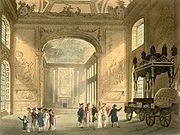 The Painted Hall of Greenwich Hospital as drawn by Augustus Pugin and Thomas Rowlandson
The Painted Hall of Greenwich Hospital as drawn by Augustus Pugin and Thomas Rowlandson
- ^ "Maritime Greenwich: Evaluation 2004". http://www.greenwichwhs.org.uk/world_heritage/documents/ManPlan2004-Part4.pdf. Retrieved 2009-02-16.
- ^ "UNESCO papers". http://whc.unesco.org/en/list/795/. Retrieved 2009-02-16.
- ^ Park Explorer- East Greenwich Pleasaunce,- East Greenwich Pleasaunce
- ^ J. Bold, P. Guillery, D. Kendall, Greenwich: an architectural history of the Royal Hospital for Seamen and the Queen's House (Yale University Press) 2001.
- ^ "British History Online". http://www.british-history.ac.uk/report.aspx?compid=45274. Retrieved 2008-01-08.
- ^ Hawthorne, Nathaniel (1883). Our old home: a Series of English Sketches by Nathaniel Hawthorne. Boston: Houghton, Mifflin and Co.
- ^ "Photographs of the Old Royal Naval College". http://www.urban75.org/london/greenwich-london.html. Retrieved 2009-02-16.
- ^ "British movie filming locations:Greenwich Royal Naval College". http://www.ukonscreen.com/1102-Greenwich-Royal-Naval-College-filming-locations.html. Retrieved 2010-08-07.
Other links
Old Royal Naval College:
- Greenwich Foundation for the Old Royal Naval College - the official website
- University of Greenwich
- Trinity College of Music
- Greenwich World Heritage Site
- Photos from the conversion
Greenwich Hospital (London):
Coordinates: 51°29′1.2″N 00°00′21.4″W / 51.483667°N 0.005944°W
- The Royal Hospital School
- There is also a Greenwich Hospital located in Greenwich, Connecticut.
- List of hospitals in the UK
Royal Naval College, Greenwich:
Categories:- English Baroque architecture
- Christopher Wren London buildings
- Christopher Wren churches in London
- Royal Navy
- Hospitals in London
- Cultural and educational buildings in London
- Buildings and structures in Greenwich
- Health in Greenwich
- History of Greenwich
- Royal buildings in London
- Military museums in London
- Nicholas Hawksmoor buildings
- Military veterans' affairs in the United Kingdom
- Military-related organizations
- Grade I listed buildings in London
- Grade I listed hospital buildings
- Military units and formations established in 1694
- Buildings and structures completed in 1705
- Buildings and structures completed in 1742
- 1694 establishments in England
- 1873 establishments in England
- 1998 disestablishments
- University of Greenwich
- Military history of the United Kingdom
- Military history of London
- Royal Naval College, Greenwich
- Educational institutions disestablished in 1998
- Defunct universities and colleges in London
- Museums in Greenwich
Wikimedia Foundation. 2010.


